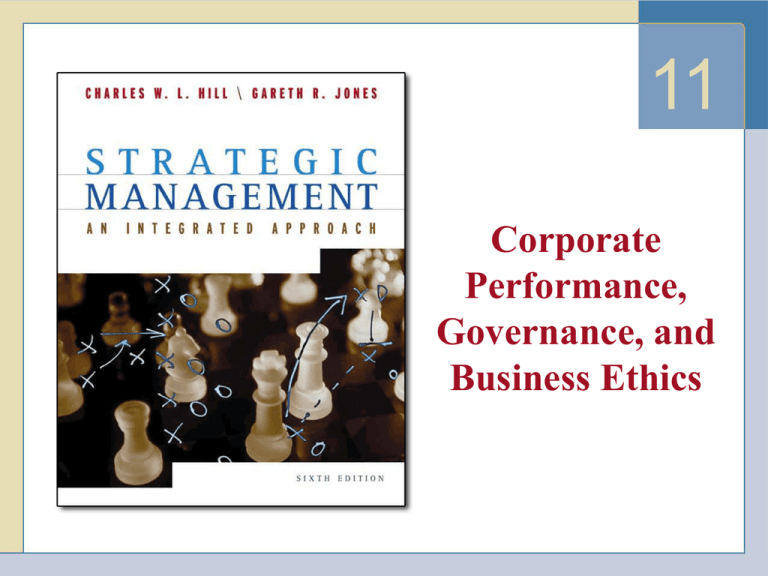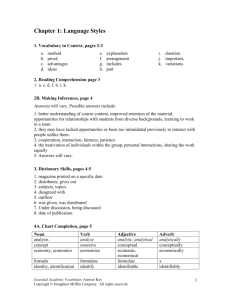
11
Corporate
Performance,
Governance, and
Business Ethics
The Causes of Poor Performance
• Poor management
–
–
–
–
Sheer incompetence
Neglect of core business
Insufficient number of good managers
Dominant, autocratic chief executive with passion
for empire-building
– Autocratic manager who tries to do it all in the
face of complexity and change
Copyright © Houghton Mifflin Company. All rights reserved.
11 - 2
The Causes of Poor Performance
• Poor management (cont’d)
–
–
–
–
–
Lack of balanced expertise at the top
Lack of strong middle management
Lack of succession planning
Failure by board to monitor strategic decisions
Unethical behavior
Copyright © Houghton Mifflin Company. All rights reserved.
11 - 3
The Causes of Poor Performance
(cont’d)
• High cost structure
– Low labor productivity
– Low capital productivity
– Inadequate financial controls
• Inadequate differentiation
– Poor product quality
– Lack of compelling product attributes
Copyright © Houghton Mifflin Company. All rights reserved.
11 - 4
The Causes of Poor Performance
(cont’d)
• Overexpansion
– Empire-building that adds little value
– Loss of control
– Declining profitability
• Structural shifts in demand and new
competitors
– Technology
– Economic or political conditions
– Social and demographic
Copyright © Houghton Mifflin Company. All rights reserved.
11 - 5
The Causes of Poor Performance
(cont’d)
• Organizational inertia
– Distribution of power and influence in the
organization
– Organization culture
– Preconceptions about the appropriate business
model
Copyright © Houghton Mifflin Company. All rights reserved.
11 - 6
Strategic Change: Improving
Performance
• Changing the leadership
– New leader is often from outside the company
– New leader must make difficult decisions,
motivate, listen, and delegate
• Changing the strategy
–
–
–
–
Redefine strategic focus
Divest unwanted assets
Improve profitability
Make acquisitions
Copyright © Houghton Mifflin Company. All rights reserved.
11 - 7
Strategic Change: Improving
Performance (cont’d)
• Changing the organization
– Unfreezing the organization
• Big bang theory of change
• Senior managers must be committed to it
– Movement
• Speed
• Involving employees
– Refreezing the organization
• Culture, socialization, management education programs
• Hiring policies, control and incentive systems
Copyright © Houghton Mifflin Company. All rights reserved.
11 - 8
Stakeholders and the Enterprise
Copyright © Houghton Mifflin Company. All rights reserved.
11 - 9
Stakeholder Impact Analysis
• Identify the stakeholders most critical to survival
– Identify stakeholders.
– Identify stakeholders’ interests and concerns.
– As a result, identify what claims stakeholders are likely to
make on the organization.
– Identify the stakeholders who are most important to the
organization’s perspective.
– Identify the resulting strategic challenges.
• Usually the most important:
– Customers, employees, stockholders
Copyright © Houghton Mifflin Company. All rights reserved.
11 - 10
The Unique Role of Stockholders
• Legal owners
• Providers of risk capital, a major source of
capital
– No guarantee that stockholders will recoup their
investment or earn a decent return
• Maximizing return to stockholders
• Employees as stockholders
Copyright © Houghton Mifflin Company. All rights reserved.
11 - 11
Profitability and Stakeholder Claims
• Stockholders’ returns
– Dividend payments
– Capital appreciation in market value of a share
• Maximizing long-run ROIC
– Within limits set by law
– In a manner consistent with societal expectations
Copyright © Houghton Mifflin Company. All rights reserved.
11 - 12
Relationship Between ROIC, Stakeholder
Satisfaction, and Stakeholder Support
Copyright © Houghton Mifflin Company. All rights reserved.
11 - 13
Agency Theory
• Problems can arise in a business relationship
when one person delegates decision making
authority to another
• Principal-agent relationships
– Agency relationship: when one party delegates
decision-making authority to another
– Principal: person delegating authority
– Agent: person to whom authority is delegated
Copyright © Houghton Mifflin Company. All rights reserved.
11 - 14
The Agency Problem
• Agents and principals may have different goals
• Agents may pursue goals that are not in the best
interests of their principals
– Information asymmetry: Agents almost always have more
information
• Difficult for principals to measure performance
• Trust
– On-the-job consumption
– Empire building
Copyright © Houghton Mifflin Company. All rights reserved.
11 - 15
The Tradeoff Between Profitability and
Revenue Growth Rates
Copyright © Houghton Mifflin Company. All rights reserved.
11 - 16
The Challenge for Principals
• Shape the behavior of agents so that they act in
accordance with goals set by principals
• Reduce information asymmetry
• Develop mechanisms for removing agents who
do not act in accordance with goals of
principals
Copyright © Houghton Mifflin Company. All rights reserved.
11 - 17
Governance Mechanisms
• The board of directors
–
–
–
–
–
–
–
Elected by stockholders
Legally accountable
Monitors corporate strategy decisions
Authority to hire, fire, and compensate
Ensures accuracy of audited financial statements
Inside directors
Outside directors
Copyright © Houghton Mifflin Company. All rights reserved.
11 - 18
Governance Mechanisms (cont’d)
• Stock-based compensation
– Pay-for-performance
– Stock options
• The right to buy company shares at a predetermined
price at some point in the future
Copyright © Houghton Mifflin Company. All rights reserved.
11 - 19
How Options Skew the Bottom Line
Source: D. Henry and M. Conlin, “Too Much of a Good Incentive?” Business Week,
March 4, 2002, pp. 38–39.
Copyright © Houghton Mifflin Company. All rights reserved.
11 - 20
Governance Mechanisms (cont’d)
• Financial statements and auditors
– SEC
– GAAP
• The takeover constraint
– Corporate raiders
• Greenmail
Copyright © Houghton Mifflin Company. All rights reserved.
11 - 21
Governance Mechanisms Inside a
Company
• Strategic control systems
– To establish standards against which performance
can be measured
– To create systems for measuring and monitoring
performance regularly
– To compare actual performance against targets
– To evaluate results and take corrective actions
Copyright © Houghton Mifflin Company. All rights reserved.
11 - 22
A Balanced Scorecard Approach
Copyright © Houghton Mifflin Company. All rights reserved.
11 - 23
Governance Mechanisms Inside a
Company (cont’d)
• Employee incentives
– Employee stock ownership plans
– Stock options
– Compensation tied to attainment of superior
efficiency, quality, innovation, and responsiveness
to customers
Copyright © Houghton Mifflin Company. All rights reserved.
11 - 24
Ethics and Strategy
• Ethical decision
– One that typical stakeholders would find
acceptable because it aids stakeholders, the
organization, or society
• Unethical decision
– One that a manager would prefer to disguise or
hide because it enables a company or individual to
gain at the expense of society or other stakeholders
Copyright © Houghton Mifflin Company. All rights reserved.
11 - 25
The Purpose of Business Ethics
• To give people the tools for dealing with moral
complexity in business
• Business decisions have an ethical component
• Ethical implications must be weighed before
acting
Copyright © Houghton Mifflin Company. All rights reserved.
11 - 26
Shaping the Ethical Climate of an
Organization
• Top managers must use their leadership
position to incorporate an ethical dimension
into the values they stress
• Ethical values must be incorporated into the
company’s mission statement
• Ethical values must be acted on
Copyright © Houghton Mifflin Company. All rights reserved.
11 - 27
Comparing Utilitarian, Moral Rights,
and Justice
Copyright © Houghton Mifflin Company. All rights reserved.
11 - 28
Comparing Utilitarian, Moral Rights,
and Justice
Copyright © Houghton Mifflin Company. All rights reserved.
11 - 29
Comparing Utilitarian, Moral Rights,
and Justice
Copyright © Houghton Mifflin Company. All rights reserved.
11 - 30
Thinking Through Ethical Problems
• Does my decision fall within the accepted
values or standards that typically apply in the
organizational environment?
• Am I willing to see the decision communicated
publicly to all stakeholders affected by it?
• Would the people with whom I have a
significant personal relationship approve of the
decision?
Copyright © Houghton Mifflin Company. All rights reserved.
11 - 31
Thinking Through Ethical Problems
(cont’d)
• Step 1: Identify which stakeholders the
decision would affect and in what ways
• Step 2: Judge the ethics of the proposed
strategic decision given the information from
Step 1
• Step 3: Establish moral intent (resolve to place
moral concerns ahead of other concerns)
• Step 4: Engage in ethical behavior
Copyright © Houghton Mifflin Company. All rights reserved.
11 - 32

